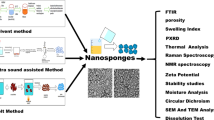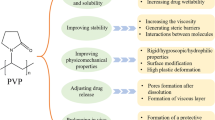Abstract
The objective of this work was to study dissolution enhancement efficiency and solid dispersion formation ability of hydrophilic swellable polymers such as sodium carboxymethyl cellulose (Na-CMC), sodium starch glycolate (SSG), pregelatinized starch (PGS), and hydroxypropylmethyl cellulose (HPMC) with carbamazepine using 32 full factorial design for each of the polymers. Solid dispersions of carbamazepine were prepared using solvent evaporation method with around 70% solvent recovery. The independent variables were the amount of polymer and organic solvent. The dependent variables assessed were percentage drug dissolved at various time points and dispersion efficiency (ie, in terms of particle size of solid dispersion). Solid dispersions were evaluated for percentage drug dissolved, wettability, differential scanning calorimetry, scanning electron microscopy, and angle of repose. Multiple linear regression of results obtained led to equations, which generated contour plots to relate the dependent variables. Similarity factor and mean dissolution time were used to compare dissolution patterns obtained in distilled water and simulated gastric fluid United States Pharmacopeia (USP) XXVI of pH 1.2. Maximum drug dissolution was obtained with polymer order Na-CMC>SSG>PGS>HPMC. Particle size of drug was reduced ≈ 10–15, 3–5, 5–7, and 10–25 times in Na-CMC, SSG, PGS, and HPMC solid dispersions, respectively; whereas wettability of solid dispersions was found in the order of Na-CMC>HPMC>PGS>SSG. Angle of repose was found to be in the range of 29° to 35° for all solid dispersions, which shows good flowability characteristics. HPMC showed increase in drug dissolution up to an optimized level; however, furthers increase in its concentration decreased drug dissolution.
Similar content being viewed by others
References
Lobenberg R, Amidon GL. Modern bioavailability, bioequivalence and biopharmaceutics classification system: new scientific approaches to international regulatory standards.Eur J. Pharm Biopharm. 2000; 50:3–12.
Desai KGH, Kulakarni AR, Aminbhavi TM. Solubility of Rofecoxib in presence of methanol, ethanol and sodium lauryl sulphate at (298.15, 303.15 and 308.15) K.J Chem Engl Data. 2003;48: 942–945.
Rawat S, Jain SK. Rofecoxib—cyclodextrin inclusion complex for solubility enhancement.Pharmazie. 2003;58:639–641.
Moneghini M, Voinovich D, Perissutti B, Princivalle F. Action of carriers on carbamazepine dissolution.Pharm Dev Technol. 2002; 7:289–296.
Bertilsson L. Clinical pharmacokinetics of carbamazepine.Clin Pharmacokinet. 1978;3:128–143.
Nokhodchi A, Javadzadeh Y, Siahi-Shadbad MR, Barzegar-Jalali M. The effect of type and concentration of vehicles on the dissolution rate of a poorly soluble drug (indomethacin) from liquisolid compacts.J Pharm Pharm Sci. 2005;8:18–25.
Spireas S, Jarowski CI, Rohera DI. Powdered solution technology: principles and mechanism.Pharm Res. 1992;9:1351–1368.
Javadzadeh Y, Siahi-Shadbad MR, Barzegar-Jalali M, Nokhodchi A. Enhancement of dissolution rate of piroxicam using liquisolid compacts.Farmaco. 2005;60:361–365.
ABBOTT GmbH and Co. Soliqs: nanomorph technology. Accessed November 5, 2005.
Rasenack N, Hartenhauer H, Müller B. Microcrystals for dissolution rate enhancement of poorly water-soluble drugs.Int J Pharm. 2003; 254:137–145.
Rasenack N, Müllers BPR. Dissolution rate enhancement by in situ micronization of poorly water-soluble drugs.Pharm Res. 2002;19: 1894–1900.
Sertsou G, Butler J, Scott A, Hempenstall J, Rades T. Factors affecting incorporation of drug into solid solution with HPMCP during solvent change coprecipitation.Int J Pharm. 2002;245:99–108.
Bakatselou V, Oppenheim RC, Dressman JB. Solubilization and wetting effects of bile salts on the dissolution of steroids.Pharm Res. 1991;8:1461–1469.
Valizadeh H, Nokhodchi A, Qarakhani N, et al. Physicochemical characterization of solid dispersions of indomethacin PEG 6000, Myrj 52, lactose, sorbitol, dextrin, and Eudragit E100.Drug Dev Ind Pharm. 2004;30:303–317.
Chiou WL, Reigelman S. Pharmaceutical applications of solid dispersion systems.J Pharm Sci. 1971;60:1281–1302.
Leuner C, Dressman J. Improving drug solubility for oral delivery using solid dispersions.Eur J Pharm Biopharm. 2000;50:47–60.
Ford JL. The current status of solid dispersions.Pharm Acta Helv. 1986;61:69–88.
Goldberg AH, Gibaldi M, Kanig JL. Increasing dissolution rates and gastrointestinal absorption of drugs via solid solutions and eutectic mixtures. II. Experimental evaluations of a eutectic mixture: urea-acetaminophen system.J Pharm Sci. 1966;55:581–583.
El-Zein H, Riad L, El-Bary AA. Enhancement of carbamazepine dissolution: in vitro and in vivo evaluation.Int J Pharm. 1998;168: 209–220.
Narang AS, Srivastava AK. Evaluation of solid dispersions of clofazimine.Drug Dev Ind Pharm. 2002;28:1001–1013.
Hancock BC, Parks M. What is true solubility advantage for amorphous pharmaceuticals?Pharm Res. 2000;17:397–404.
Gohel MC, Panchal MK. Comparison of in vitro dissolution profiles using a novel, model-independents approach.Pharm Technol. 2000;24: 92–102.
Gohel MC, Panchal MK. Novel use of similarity factor f2 and Sd for the development of diltiazem HCl modified-release tablets using a 32 factorial design.Drug Dev Ind Pharm. 2002;28:77–87.
Derringer G, Suich R. Simultaneous optimization of several responses variables.J Qual Tech. 1980;12:214–219.
Gohel MC, Patel LD. Processing of nimesulide-PEG 400-PG-PVP solid dispersions: preparation, characterization and in vitro dissolution.Drug Dev Ind Pharm. 2005;29:299–310.
McKenna A, McCafferty DF. Effect of particle size on the compaction mechanism and tensile strength of tablets.J Pharm Pharmacol 1982;34:347–351.
Cao QR, Choi HG, Kim DC, Lee BJ. Release behavior and photo-image of nifedipine tablet coated with high viscosity grade hydroxypropylmethylcellulose: effect of coating conditions.Int J Pharm. 2004;274:107–117.
Mashru RC, Sutariya VB, Sankalia MG, Sankalia JM, Parikh PP. Development and evaluation of fast dissolving film of salbutamol sulphate.Drug Dev Ind Pharm. 2005;31:25–34.
Barzegar-Jalali M, Maleki N, Garjani A, et al. Enhancement of dissolution rate and anti-inflammatory effects of piroxicam using solvent deposition technique.Drug Dev Ind Pharm. 2002;28:681–686.
Arias MJ, Gines JM, Moyano JR, Rabasco AM. Dissolution properties and in vivo behaviour of triamterence in solid dispersions with polyethylene glycols.Pharm Acta Helv. 1996;71:229–235.
Chowdary KP, Rao SS. Investigation of dissolution enhancement of itraconazole by solid dispersion in superdisintegrants.Drug Dev Ind Pharm. 2000;26:1207–1211.
Okimoto K, Miyake M, Ibuki R, Yasumura M, Ohnishi N, Nakai T. Dissolution mechanism and rate of solid dispersion particles of nilvadipine with hydroxypropylmethylcellulose.Int J Pharm. 1997;159:85–93.
Author information
Authors and Affiliations
Corresponding author
Additional information
Published: April 6, 2007
Rights and permissions
About this article
Cite this article
Rane, Y., Mashru, R., Sankalia, M. et al. Effect of hydrophilic swellable polymers on dissolution enhancement of carbamazepine solid dispersions studied using response surface methodology. AAPS PharmSciTech 8, 27 (2007). https://doi.org/10.1208/pt0802027
Received:
Accepted:
DOI: https://doi.org/10.1208/pt0802027




